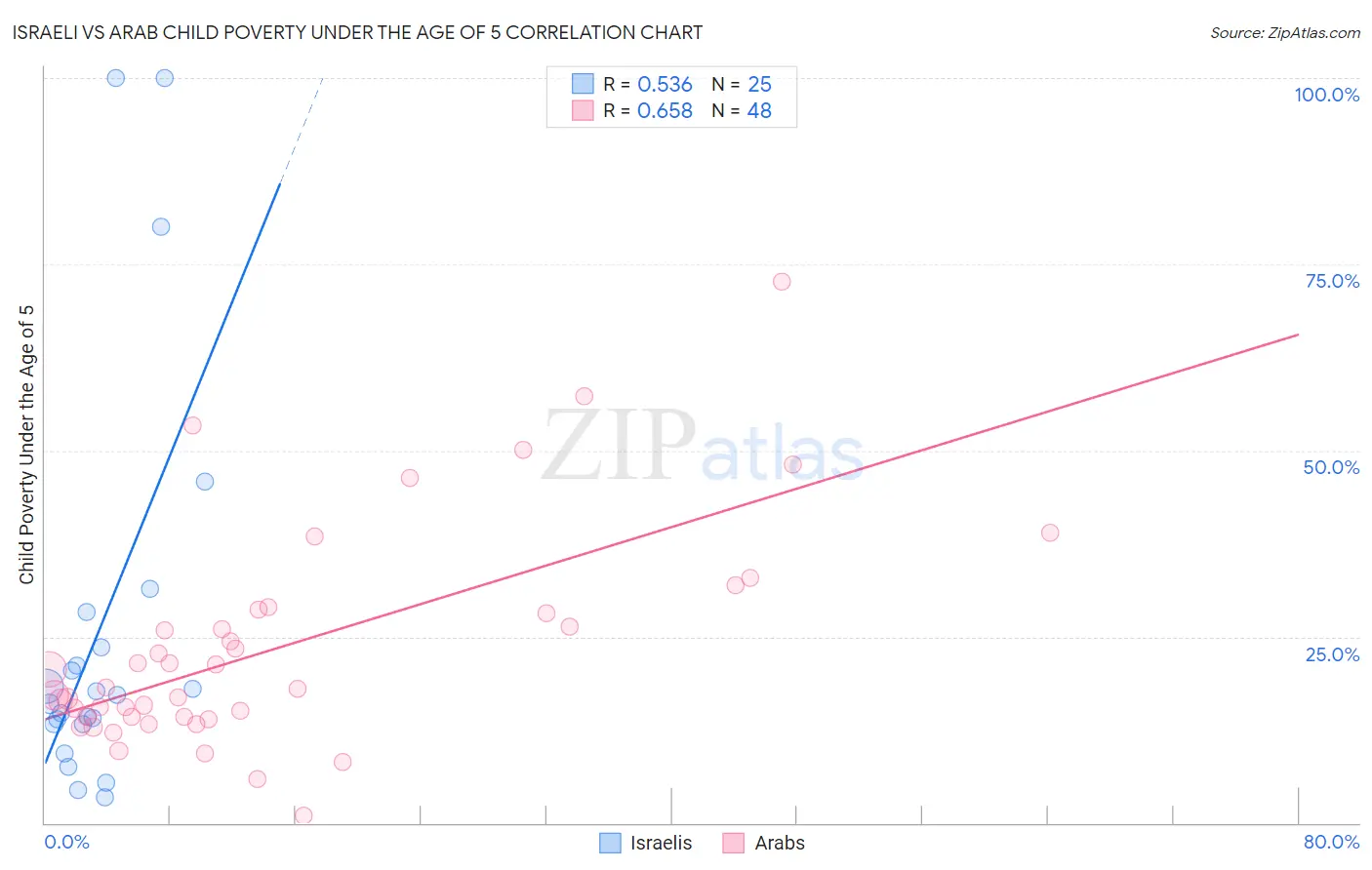Israeli vs Arab Child Poverty Under the Age of 5
COMPARE
Israeli
Arab
Child Poverty Under the Age of 5
Child Poverty Under the Age of 5 Comparison
Israelis
Arabs
16.6%
CHILD POVERTY UNDER THE AGE OF 5
82.0/ 100
METRIC RATING
146th/ 347
METRIC RANK
17.4%
CHILD POVERTY UNDER THE AGE OF 5
40.7/ 100
METRIC RATING
182nd/ 347
METRIC RANK
Israeli vs Arab Child Poverty Under the Age of 5 Correlation Chart
The statistical analysis conducted on geographies consisting of 203,705,718 people shows a substantial positive correlation between the proportion of Israelis and poverty level among children under the age of 5 in the United States with a correlation coefficient (R) of 0.536 and weighted average of 16.6%. Similarly, the statistical analysis conducted on geographies consisting of 461,564,748 people shows a significant positive correlation between the proportion of Arabs and poverty level among children under the age of 5 in the United States with a correlation coefficient (R) of 0.658 and weighted average of 17.4%, a difference of 5.1%.

Child Poverty Under the Age of 5 Correlation Summary
| Measurement | Israeli | Arab |
| Minimum | 3.4% | 0.94% |
| Maximum | 100.0% | 72.7% |
| Range | 96.6% | 71.8% |
| Mean | 26.1% | 23.4% |
| Median | 17.2% | 18.1% |
| Interquartile 25% (IQ1) | 13.3% | 14.3% |
| Interquartile 75% (IQ3) | 25.9% | 28.4% |
| Interquartile Range (IQR) | 12.7% | 14.2% |
| Standard Deviation (Sample) | 27.1% | 14.5% |
| Standard Deviation (Population) | 26.5% | 14.4% |
Similar Demographics by Child Poverty Under the Age of 5
Demographics Similar to Israelis by Child Poverty Under the Age of 5
In terms of child poverty under the age of 5, the demographic groups most similar to Israelis are Immigrants from Ethiopia (16.6%, a difference of 0.020%), Ethiopian (16.5%, a difference of 0.12%), Samoan (16.5%, a difference of 0.18%), Portuguese (16.5%, a difference of 0.19%), and Immigrants from Western Europe (16.5%, a difference of 0.24%).
| Demographics | Rating | Rank | Child Poverty Under the Age of 5 |
| Immigrants | Hungary | 84.5 /100 | #139 | Excellent 16.5% |
| Guamanians/Chamorros | 84.2 /100 | #140 | Excellent 16.5% |
| Immigrants | Western Europe | 83.3 /100 | #141 | Excellent 16.5% |
| Portuguese | 83.0 /100 | #142 | Excellent 16.5% |
| Samoans | 83.0 /100 | #143 | Excellent 16.5% |
| Ethiopians | 82.7 /100 | #144 | Excellent 16.5% |
| Immigrants | Ethiopia | 82.1 /100 | #145 | Excellent 16.6% |
| Israelis | 82.0 /100 | #146 | Excellent 16.6% |
| Immigrants | Nepal | 80.3 /100 | #147 | Excellent 16.6% |
| Syrians | 79.1 /100 | #148 | Good 16.6% |
| New Zealanders | 78.7 /100 | #149 | Good 16.6% |
| Colombians | 77.8 /100 | #150 | Good 16.7% |
| Canadians | 77.6 /100 | #151 | Good 16.7% |
| Belgians | 77.2 /100 | #152 | Good 16.7% |
| Dutch | 77.1 /100 | #153 | Good 16.7% |
Demographics Similar to Arabs by Child Poverty Under the Age of 5
In terms of child poverty under the age of 5, the demographic groups most similar to Arabs are Immigrants from Germany (17.4%, a difference of 0.030%), Lebanese (17.4%, a difference of 0.040%), Hawaiian (17.4%, a difference of 0.080%), South American Indian (17.4%, a difference of 0.080%), and Immigrants from Costa Rica (17.4%, a difference of 0.18%).
| Demographics | Rating | Rank | Child Poverty Under the Age of 5 |
| Immigrants | Lebanon | 47.6 /100 | #175 | Average 17.3% |
| Immigrants | Iraq | 45.2 /100 | #176 | Average 17.3% |
| Immigrants | Sierra Leone | 43.6 /100 | #177 | Average 17.3% |
| Immigrants | Cameroon | 42.7 /100 | #178 | Average 17.4% |
| Hawaiians | 41.5 /100 | #179 | Average 17.4% |
| South American Indians | 41.4 /100 | #180 | Average 17.4% |
| Immigrants | Germany | 41.0 /100 | #181 | Average 17.4% |
| Arabs | 40.7 /100 | #182 | Average 17.4% |
| Lebanese | 40.3 /100 | #183 | Average 17.4% |
| Immigrants | Costa Rica | 39.0 /100 | #184 | Fair 17.4% |
| Immigrants | Armenia | 38.0 /100 | #185 | Fair 17.5% |
| Immigrants | Bosnia and Herzegovina | 35.0 /100 | #186 | Fair 17.5% |
| Kenyans | 34.7 /100 | #187 | Fair 17.5% |
| Carpatho Rusyns | 33.6 /100 | #188 | Fair 17.5% |
| French | 33.6 /100 | #189 | Fair 17.5% |